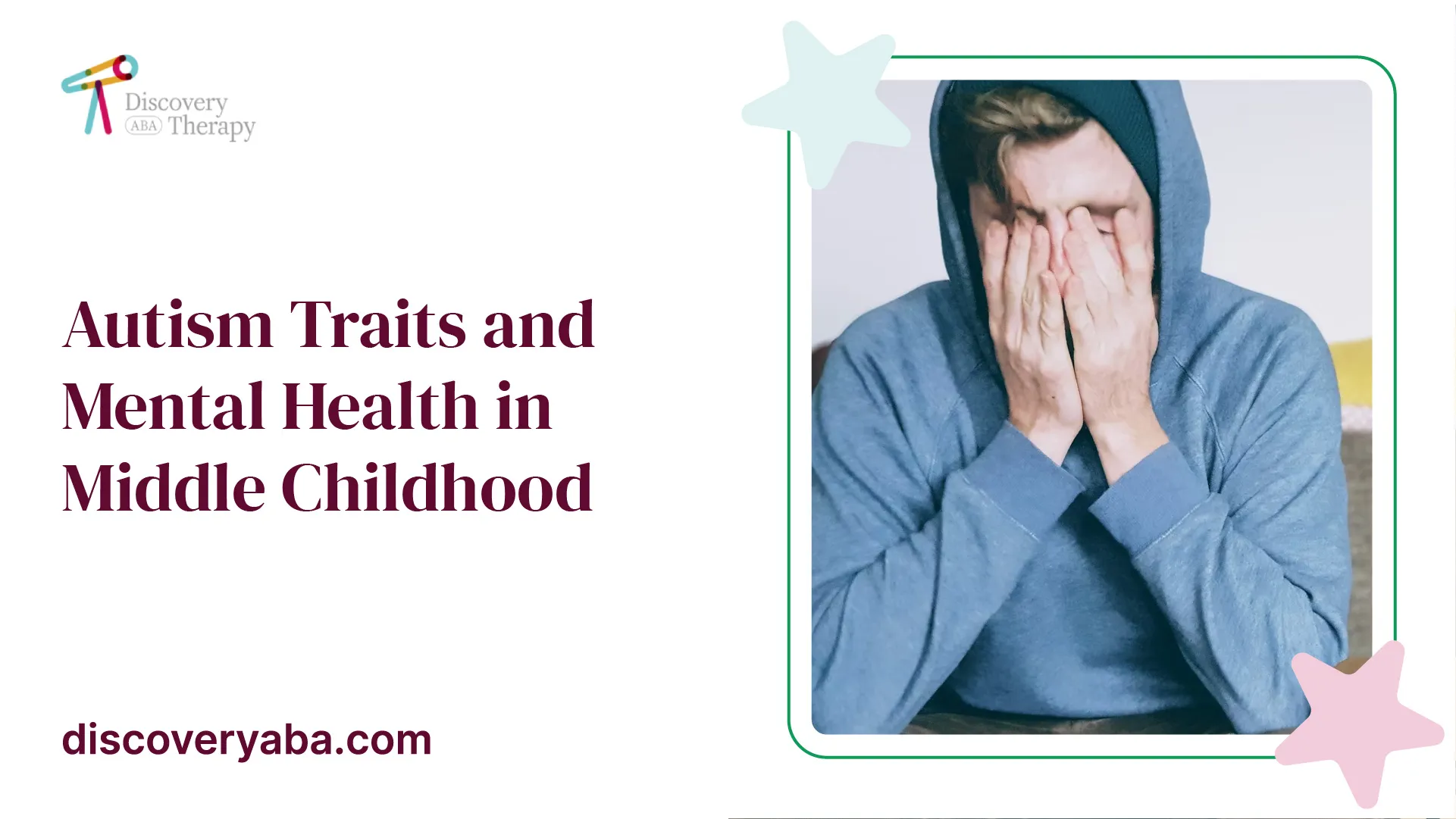Autism Traits and Mental Health in Middle Childhood
In this article, we’ll explore some of the most common autism traits in middle childhood and how they can impact mental health.
.jpeg)
Understanding Autism Traits in Middle Childhood
When it comes to understanding and supporting children with autism traits in middle childhood, it is important to have a clear understanding of what these traits entail.
Autism traits refer to the unique characteristics and behaviors that are commonly observed in individuals on the autism spectrum. In middle childhood, these traits may become more pronounced and have a significant impact on a child's daily life and interactions.
What are Autism Traits?
Autism traits are a set of neurodevelopmental characteristics that affect social interaction, communication, and behavior. These traits are typically present from early childhood and can persist throughout a person's life.
While the specific traits and their intensity can vary from person to person, they generally revolve around difficulties in social interaction, communication, and sensory processing.
Characteristics of Autism Traits in Middle Childhood
In middle childhood, children with autism traits may exhibit a range of characteristics that are indicative of their unique neurodevelopmental profile. Some common characteristics include:
- Social Challenges: Children with autism traits may struggle with social interactions and have difficulty understanding social cues, making and maintaining friendships, and engaging in reciprocal conversations. They may have a limited understanding of nonverbal communication and social norms.
- Communication Challenges: Language and communication difficulties are also common in middle childhood. Children may have delayed language development, difficulty understanding abstract language, and challenges with expressive language. They may exhibit repetitive language patterns or have a tendency to take language literally.
- Sensory Challenges: Many children with autism traits experience sensory sensitivities or sensory-seeking behaviors. They may be hypersensitive to certain sounds, textures, or smells, leading to sensory overload or meltdowns. On the other hand, some children may seek sensory stimulation, engaging in repetitive behaviors like rocking or hand-flapping.
Understanding these characteristics is crucial for parents and caregivers as it enables them to provide targeted support and interventions that meet the specific needs of their child. By recognizing and acknowledging these traits, parents can take steps to create an environment that fosters their child's development and well-being.

Challenges Faced by Children with Autism Traits
Children with autism traits in middle childhood often face unique challenges that can impact their daily lives and overall well-being. These challenges can be categorized into social, communication, and sensory difficulties.
Social Challenges
Children with autism traits typically struggle with social interactions and developing meaningful relationships with their peers. They may have difficulty understanding social cues, interpreting nonverbal communication, and engaging in reciprocal conversations. These challenges can lead to feelings of isolation and exclusion.
Social Challenges
- Difficulty understanding social cues
- Challenges interpreting nonverbal communication
- Struggles with engaging in reciprocal conversations
- Feelings of isolation and exclusion
Communication Challenges
Communication difficulties are another common challenge experienced by children with autism traits. They may struggle with both verbal and nonverbal communication skills. Some children may have limited speech or language delays, while others may have difficulty understanding and using appropriate language in social situations.
Communication Challenges
- Limited speech or language delays
- Difficulty understanding and using appropriate language
- Challenges in expressing thoughts or emotions
- Difficulty engaging in back-and-forth conversation
Sensory Challenges
Children with autism traits often have sensory sensitivities or differences that can impact their daily functioning. They may experience heightened sensitivity or under-responsiveness to certain sensory stimuli, such as sound, touch, taste, smell, or visual input. These sensory challenges can lead to sensory overload or avoidance behaviors.
Sensory Challenges
- Heightened sensitivity or under-responsiveness to sensory stimuli
- Sensory overload in certain environments
- Avoidance of sensory experiences
- Difficulty with sensory integration
Understanding and addressing these challenges is crucial for supporting children with autism traits in middle childhood. By recognizing their unique needs and providing appropriate strategies and support, parents and caregivers can help children navigate these challenges and thrive in their daily lives.
Building Bridges: Support Strategies for Parents
When it comes to supporting children with autism traits in middle childhood, parents play a crucial role in creating a nurturing and inclusive environment. By implementing specific strategies, parents can help bridge the gaps and support their children's development. Here are three essential support strategies for parents:
Creating a Supportive Environment
Creating a supportive environment is key to promoting the well-being and development of children with autism traits. This involves establishing routines, providing clear expectations, and ensuring a calm and structured atmosphere. By creating a predictable environment, parents can help reduce anxiety and provide a sense of security for their child.
In addition, it is important to consider sensory sensitivities that children with autism traits may experience. This can involve making adjustments such as reducing noise levels, providing sensory-friendly spaces, and using visual supports to aid in communication and understanding.
Enhancing Social Skills
Social skills development is a significant area of focus for children with autism traits. Parents can support their child's social growth by providing opportunities for social interaction, both at home and in the community. Encouraging participation in social activities, such as playdates or joining clubs or groups, can help children practice social skills in a safe and supportive environment.
Using visual supports, such as social stories or visual schedules, can also assist children in understanding social expectations and navigating social situations. It is important for parents to model and reinforce positive social behaviors, such as taking turns, sharing, and using appropriate language, to help their child develop social skills effectively.
Communication Strategies
Effective communication is vital for children with autism traits to express their needs, thoughts, and emotions. Parents can implement various communication strategies to support their child's communication development. This may include using visual aids, such as picture schedules or communication boards, to enhance understanding and facilitate communication.
Additionally, using clear and concise language, providing visual cues, and using gestures or sign language can assist in conveying information more effectively. It is important for parents to actively listen and give their child ample time to process and respond during conversations. This promotes a supportive and patient communication environment.
By implementing these support strategies, parents can play an integral role in helping their children with autism traits navigate the challenges they may face in middle childhood. Creating a supportive environment, enhancing social skills, and utilizing effective communication strategies can contribute to their child's overall development, well-being, and success.
Promoting Mental Health in Children with Autism Traits
Supporting the mental health of children with autism traits is essential to their overall well-being. In middle childhood, there are specific strategies that can help promote positive mental health outcomes. This section explores emotional regulation techniques, anxiety and stress management, and building self-esteem and confidence.
Emotional Regulation Techniques
Children with autism traits may experience difficulties in regulating their emotions. Teaching them effective emotional regulation techniques can help them navigate challenging situations more effectively. Here are some techniques that can be beneficial:
Anxiety and Stress Management
Anxiety and stress can be common challenges for children with autism traits. Implementing effective strategies to manage anxiety and stress can greatly improve their mental well-being. Here are some approaches that can be helpful:
Building Self-Esteem and Confidence
Fostering self-esteem and confidence is crucial for the mental well-being of children with autism traits. Building a positive self-image and helping them recognize their strengths can contribute to their overall happiness and resilience. Here are some strategies to promote self-esteem and confidence:
By implementing these strategies, parents can actively promote the mental health and well-being of their children with autism traits in middle childhood. It is important to remember that each child is unique, and strategies may need to be tailored to their individual needs and preferences.
Collaborating with Professionals
When it comes to supporting children with autism traits in middle childhood, collaboration with professionals is essential. These professionals, including teachers, school staff, and community organizations, play a crucial role in providing the necessary support and resources. In this section, we will explore the different aspects of collaborating with professionals to help children with autism traits thrive.
Working with Teachers and School Staff
Teachers and school staff play a vital role in the education and development of children with autism traits. Establishing open lines of communication and collaboration with them is key to ensuring a supportive learning environment. Here are some strategies for working with teachers and school staff:
- Share information: Provide teachers with relevant information about your child's autism traits, including their strengths, challenges, and any specific accommodations or strategies that have been effective in the past.
- Individualized Education Plan (IEP): Collaborate with the school to develop an IEP that outlines specific goals, accommodations, and support services tailored to your child's needs.
- Regular communication: Maintain open and ongoing communication with teachers to discuss your child's progress, challenges, and any adjustments that may be needed to support their learning.
Seeking Professional Support
In addition to working with teachers and school staff, seeking professional support can greatly benefit children with autism traits. Professionals such as psychologists, therapists, and behavior analysts can provide specialized interventions and strategies. Here are some avenues for seeking professional support:
Consulting with these professionals can help you gain valuable insights, access evidence-based interventions, and receive guidance on how to best support your child's unique needs.
Connecting with Supportive Communities
Building connections with supportive communities can provide a valuable network of individuals who understand and can empathize with the experiences of raising a child with autism traits. Here are some ways to connect with supportive communities:
- Support groups: Join local support groups or online communities where you can connect with other parents facing similar challenges. These groups often provide a safe space to share experiences, seek advice, and find emotional support.
- Nonprofit organizations: Explore nonprofit organizations that focus on autism advocacy and support. These organizations often offer resources, workshops, and events that can enhance your knowledge and connect you with a broader community.
- Parent training programs: Consider participating in parent training programs that provide education and strategies for effectively supporting your child's development and well-being.
Collaborating with professionals, including teachers, school staff, and supportive communities, can make a significant difference in the lives of children with autism traits. By working together, parents and professionals can create a network of support and resources that empowers these children to reach their full potential.
FAQs
What causes autism?
The exact cause of autism is unknown, but researchers believe that a combination of genetic and environmental factors may play a role.
Can autism be cured?
There is no cure for autism, but early intervention and treatment can help children with autism develop important skills and improve their quality of life.
How can I tell if my child has autism?
If you’re concerned about your child’s development, talk to their doctor. They may refer you to a specialist for further evaluation. Some common signs of autism include delayed speech or social skills, repetitive behaviors, and sensory sensitivities.
Will my child with autism be able to live independently as an adult?
Every individual with autism is unique, but many adults with autism are able to live independently or with support from family or caregivers. Early intervention and treatment can help prepare children with autism for adulthood.
Conclusion
Autism traits can impact mental health in middle childhood, but with the right support, children with autism can thrive. By understanding your child’s unique needs and strengths, you can help them navigate the challenges of growing up with autism. Remember, you are not alone. There are many resources available to help you and your child on this journey.
Sources
Does Your Child Have An Autism Diagnosis?
Learn More About How ABA Therapy Can Help
Find More Articles
Contact us
North Carolina, Nevada, Utah, Virginia
New Hampshire, Maine
Arizona, Colorado, Georgia, New Mexico, Oklahoma, Texas
.avif)




































































































